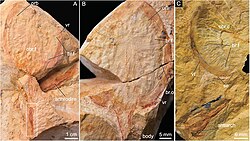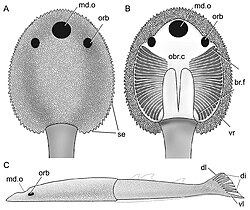Biology:Foxaspis
| Foxaspis | |
|---|---|

| |
| Photographs of the holotype and paratype | |
| Scientific classification | |
| Domain: | Eukaryota |
| Kingdom: | Animalia |
| Phylum: | Chordata |
| Infraphylum: | Agnatha |
| Class: | Cephalaspidomorphi |
| Order: | †Polybranchiaspidiformes |
| Family: | †Duyunolepididae |
| Genus: | †Foxaspis Gai et al., 2023 |
| Type species | |
| †Foxaspis novemura Zhikun Gai, Xianghong Lin, Xianren Shan, Humberto G. Ferrón, and Philip C. J. Donoghue, 2023
| |
Foxaspis (IPA: [fɒksæspɪs]) (meaning "fox shield") is a genus of duyunolepidid galeaspid from Pragian in Guangxi; Southern China. The type and only species is F. novemura, known from two specimens consisting of a complete headshield articulated with a body and tail, and an incomplete headshield and exceptionally preserved tail.[1]
Description
Foxaspis is known from two specimens which were described in 2023 by Gai et al., (2023). The holotype, IVPP V30958.1a-b consists of a complete headshield articulated with a body and tail. The paratype, IVPP V30958.2-3, consists of an incomplete headshield and exceptionally preserved tail.[1]
Etymology
The generic name, Foxaspis (IPA: [fɒksæspɪs]), is derived from the English word fox and the Greek word aspis which roughly translates to "shield," meaning the generic name translates to "fox shield." The specific name, novemura (IPA: [no.vemˈuːrä]), which derives from the Latin words novem, which translates to "nine," and suffix -ura which refers to a tail, meaning the specific name translates to "nine tails." It was named as such after the nine-tailed fox, a mythical beast mentioned in the Shanhai jing.[1]
References
- ↑ 1.0 1.1 1.2 Gai, Zhikun; Lin, Xianghong; Shan, Xianren; Ferrón, Humberto; Donoghue, Philip (27 February 2023). "Postcranial disparity of galeaspids and the evolution of swimming speeds in stem-gnathostomes". National Science Review 10 (2): nwad050. doi:10.1093/nsr/nwad050. PMID 37266551.
Wikidata ☰ Q107751301 entry
 |


